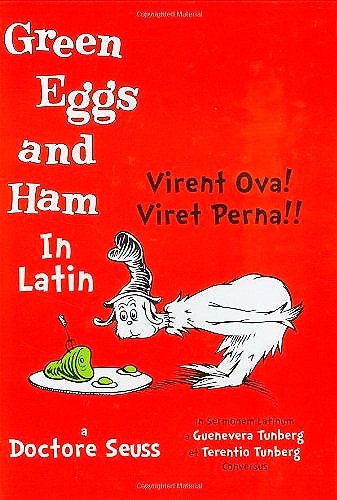Title: Green Eggs and Ham in Latin: Virent Ova! Viret Perna!
Author and Illustrator: Dr. Seuss
Translators: Jennifer Morrish Tunberg and Terence Tunberg
Year: 2003 [1960]
Tags: 1+, Picture book, Setting: Contemporary, Protagonist: animal, Language: Latin, Read-Aloud
Like the Tunbergs’ Cattus Petasatus (2000), this is a tour de force of translation. The original Green Eggs and Ham used a vocabulary of only 50 words, of which all but one (“anywhere”) were a single syllable. This made it highly accessible for beginning readers and for very young children acquiring language. Green Eggs and Ham was a smash hit thanks to its simple plot, repetitive and whimsical language, masterly rhyme and meter, delightful illustrations, and grownup-approved moral (“try a food that you don’t think you like, and you might like it after all”).
This Latin version features Seuss’ original illustrations, and the language sparkles, with rhyme and rhythms that are true to the spirit of Seuss. But this is not simple Latin. Compare “I do not like them in a box. I do not like them with a fox” with Et in cista ne daps detur! Ne me vulpes comitetur!
The Tunbergs’ Latin verse is well-suited to babies and toddlers who love read-aloud and will be enthralled by the sing-songy, repetitive language. Latin students could learn such elements as passives, deponents, and subjunctives more readily in this enjoyable context. This is also an excellent book for people who admire the art of verse translation, and for kids whose Latin is really good.
There is a Latin-to-English Vocabulary in the back of the book. The versification is explained in a dual-language guide (“How the Read These Verses”/ de ratione qua hi versus sunt legendi), and short biographies of the translators are given in both English and Latin. The text does not include macrons, but the strong, regular meter serves as a clear guide to word accent. As of this writing (27 January 2022) both Virent Ova! and Cattus Petasatus are out of print but used copies can be found on the internet. —Diane Arnson Svarlien


